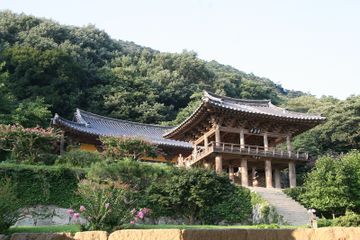"영주 부석사 안양루"의 두 판 사이의 차이
(→영문) |
(→영문) |
||
| 32번째 줄: | 32번째 줄: | ||
'''Anyangnu Pavilion of Buseoksa Temple, Yeongju''' | '''Anyangnu Pavilion of Buseoksa Temple, Yeongju''' | ||
| − | + | Anyangnu Pavilion serves as the gateway to Muryangsujeon Hall, the main worship hall of Buseoksa Temple. Built in 1576, the pavilion replaced an earlier, single-story building that burnt down in 1555. The name Anyangnu means "Pavilion of Peace and Nourishment," referring to the Western Paradise where Amitabha Buddha, whose image is enshrined in Muryangsujeon Hall, is said to reside. | |
| − | + | The pavilion features an elevated, open-air main floor laid in the traditional Korean parquet style. The area below the floor serves as a passageway, with a stone staircase leading up to the temple's main courtyard. The large hip-and-gable tile roof is supported by intricate wooden brackets placed atop both the pillars and lintels, while the coffered ceiling retains traces of colorful, painted designs. Notably, the pavilion is aligned on a slightly different axis than the buildings below it, which creates a natural harmony with the surrounding landscape. Overall, the building is considered a representative masterpiece of sixteenth-century Buddhist pavilion architecture. | |
| − | |||
| − | The pavilion features an elevated, open-air main floor laid in the traditional Korean parquet style. The area below the floor serves as a passageway, with a stone staircase leading up to the main courtyard. The large hip-and-gable tile roof is supported by intricate wooden brackets placed atop both the pillars and lintels, while the coffered ceiling retains traces of colorful, painted designs. Overall, the building is considered a representative masterpiece of sixteenth-century Buddhist pavilion architecture. | ||
===영문 해설 내용=== | ===영문 해설 내용=== | ||
2023년 11월 30일 (목) 10:58 판
| 영주 부석사 안양루 |
|
 영주 부석사 안양루, 국가문화유산포털, 문화재청. |
|
| 대표명칭 | 영주 부석사 안양루 |
|---|---|
| 한자 | 榮州 浮石寺 安養樓 |
| 주소 | 경상북도 영주시 부석면 부석사로 345 |
| 지정번호 | 보물 |
| 지정일 | 2022년 10월 31일 |
| 분류 | 유적건조물 / 종교신앙 / 불교 / 각루 |
| 소유자 | 부석사 |
| 관리자 | 부석사 |
| 시대 | 조선시대 |
| 수량/면적 | 1동 / 85.31㎡ |
| 웹사이트 | 영주 부석사 안양루, 국가문화유산포털, 문화재청. |
해설문
국문
안양루는 부석사의 문루로 16세기 사찰 문루 건축물의 대표적 사례이다. 원래 ‘강운각(羌雲閣)’이라는 단층 건물이 있었으나, 명종 10년(1555)에 불에 타서 없어졌고, 이후 선조 9년(1576)에 그 자리에 중층으로 안양루를 지었다.
건물의 아래층은 모두 기둥으로만 구성되어 있으며, 가운데 칸에 계단을 두어 무량수전으로 향하는 누하진입의 형식으로 되어 있다. 극락왕생을 의미하는 안양문이라는 현판이 걸려 있다. 위층 사방은 벽체가 없이 트여 있으며, 내부 바닥 전체가 우물마루로 되어 있다.
일주문에서 무량수전에 이르는 사찰의 동선을 범종각과 안양루 구간에서 살짝 꺾어 무량수전 영역으로 진입하게 하고 있어, 조화로운 자연미를 극대화한 것이 특징이다.
영문
Anyangnu Pavilion of Buseoksa Temple, Yeongju
Anyangnu Pavilion serves as the gateway to Muryangsujeon Hall, the main worship hall of Buseoksa Temple. Built in 1576, the pavilion replaced an earlier, single-story building that burnt down in 1555. The name Anyangnu means "Pavilion of Peace and Nourishment," referring to the Western Paradise where Amitabha Buddha, whose image is enshrined in Muryangsujeon Hall, is said to reside.
The pavilion features an elevated, open-air main floor laid in the traditional Korean parquet style. The area below the floor serves as a passageway, with a stone staircase leading up to the temple's main courtyard. The large hip-and-gable tile roof is supported by intricate wooden brackets placed atop both the pillars and lintels, while the coffered ceiling retains traces of colorful, painted designs. Notably, the pavilion is aligned on a slightly different axis than the buildings below it, which creates a natural harmony with the surrounding landscape. Overall, the building is considered a representative masterpiece of sixteenth-century Buddhist pavilion architecture.
영문 해설 내용
안양루는 부석사의 중심 전각인 무량수전 영역으로 진입하는 문루이다. 사찰에 진입하는 문들은 일직선 상에 놓이는 경우가 많은데, 안양루는 범종루에서 약간 오른쪽으로 비껴 자리하고 있어 주변 경관과의 조화로운 아름다움을 극대화하였다.
안양루는 16세기 사찰 문루 건축물의 대표적 사례이다. 원래 이 자리에는 단층 건물이 있었으나 1555년에 불에 타서 없어지고 1576년 안양루를 지었다. 건물의 아래층은 모두 기둥으로만 구성되어 있으며, 가운데 칸에 계단을 두어 무량수전으로 향할 수 있게 되어 있다. 위층 사방은 벽체가 없이 트여 있으며, 내부 바닥 전체가 우물마루로 되어 있다. 안양루 정면에는 안양문이라는 현판이 걸려 있는데, 안양은 “마음을 편안하게 지니고 몸을 쉬게 한다”는 뜻으로 극락세계를 의미한다.